Howard Reynolds Comes to Danville
Centre now had the most famous and acclaimed team to ever play in Kentucky. However, the Colonels were also drawing attention outside of the state, and each victory only made the public want to know more.
In the pre-radio world of the era, the only way to achieve more than local or state recognition was to grab the attention of major, metropolitan newspapers. Centre’s rise to national prominence owed much to the sports editor of the Boston Post, Howard G. Reynolds.
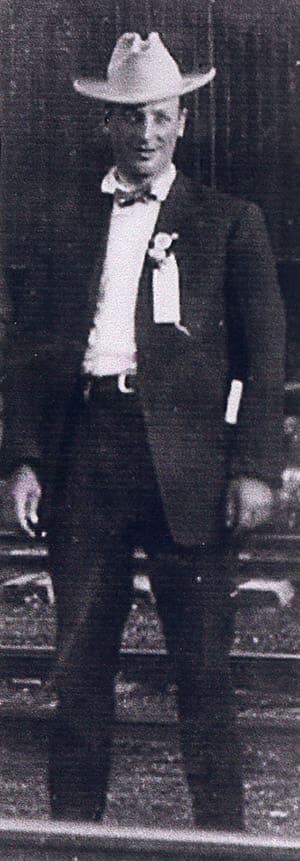
Howard G. Reynolds, sports editor of the Boston "Post"
Reynolds felt that college football had reached such a point that eastern colleges should schedule more intersectional games. His reasoning was that there was no way to accurately determine a “National Champion” if schools only played teams from their own geographical area.
He used Harvard as an example. The Crimson had been determined to have the best team in the country numerous times in the past, but since the turn of the century all of its games had been with eastern schools except for Vanderbilt, Michigan, Virginia and North Carolina. All of those games had been in Harvard Stadium. The Crimson simply hadn't felt it necessary to travel to other parts of the country.
Reynolds became interested in Centre as the 1919 season progressed. He checked ticker tape scores each week as they came in and began to pay attention to the Colonels, especially after the West Virginia win, which really made him take notice.
Finally, he decided to act and talked Eddie Mahan, a three-time All-American back from Harvard during the 1913-15 seasons, who was felt by many to be the greatest player to ever suit up for the Crimson, to join him on a trip to Danville in order to check out Centre and attend its final, Thanksgiving game with Georgetown.

Harvard's All-American Edward "Eddie" Mahan, who became a great supporter of Centre
The Bostonians arrived on a Sunday night and after checking into the Gilcher Hotel, they decided to walk the few blocks to the Centre campus. There was a light on in the basement of the gym which attracted them, so they walked down the stairs where there was a man in the locker room hunched over a goose-neck lamp and asked if he knew where Coach Moran may be.
“You’re looking at him,” Uncle Charlie replied.
Reynolds and Mahan introduced themselves and asked what he was doing.
“Repairing my boys’ equipment. Our next game may be played in the mud. Georgetown’s field doesn’t have a speck of grass. We may need these mud cleats if it rains.”
Moran could tell by the looks on their faces that the visitors were incredulous.
“This isn’t Harvard gentlemen. Down here, we do what we have to do to get along.”
The meeting in the basement later made it into the story that Reynolds filed for his story in the Post. The next day the Bostonians met with Dr. Ganfield to personally check out the rumors that had been coming out of West Virginia that Centre had cheated in order to win the game in Charleston against the Mountaineers.
Mahan was especially interested in making certain that his alma mater would never even consider the possibility of scheduling a college which cheated. After meeting with Dr. Ganfield, he was totally convinced that Centre had an honorable program and later reported such to the Harvard administration.
The next few days, the two Bostonians met with the players and watched practices. They later were quoted as saying, “These guys are for real. They well may be the greatest collection of football players in the country.”
Mahan spent considerable time with Bo. It was star with star.
“You’ve been receiving a lot of press in the East. Are you aware of this?”
Bo said he was, but, “I wish they’d write about the team, not just me.”
It was about the team. It was always the team.
On Thursday, Thanksgiving, everyone traveled on the Southern Railroad north from Danville through Lexington to Georgetown, a 50-mile ride.
Some of the Colonels’ fans had felt Centre should drop Georgetown from its schedule after the drubbing that the Tigers took in 1918, being slaughtered, 83-3. They felt a stronger opponent with more clout would be better suited to the greater aspirations of the program.
Dr. Ganfield disagreed.
“It wouldn’t be the gentlemanly thing not to play Georgetown. We have played for years. Sometimes, we are stronger. Sometime, they are. Perhaps, someone may suggest in a few years that Georgetown not play us if they are in the ascendency. We must remember that we have a long and friendly rivalry, based on the respect that we have for each other.”
Howard Reynolds and Eddie Mahan watched a track-meet type of game as Centre led 21-0 as the first quarter ended, 42-0 at the half, 63-7 after the third period, and 77-7 as the officials shortened the game by 5 minutes and blew the whistle during the final quarter.
Georgetown did manage to score, but it was only because of a mix-up on a center pass back from Red Weaver. The Centre backs were running a play where there was motion right and Red centered left and a Tiger lineman named James Moss picked up the ball and lumbered into the end zone unmolested for a score.

James L. Moss, Georgetown tackle, who picked up a misdirected Red Weaver center pass and scored one of the two touchdowns which Centre gave up during the 1919 season.
Red Weaver was 11 for 11 during the game and ended with 46 straight extra points after his last kick.
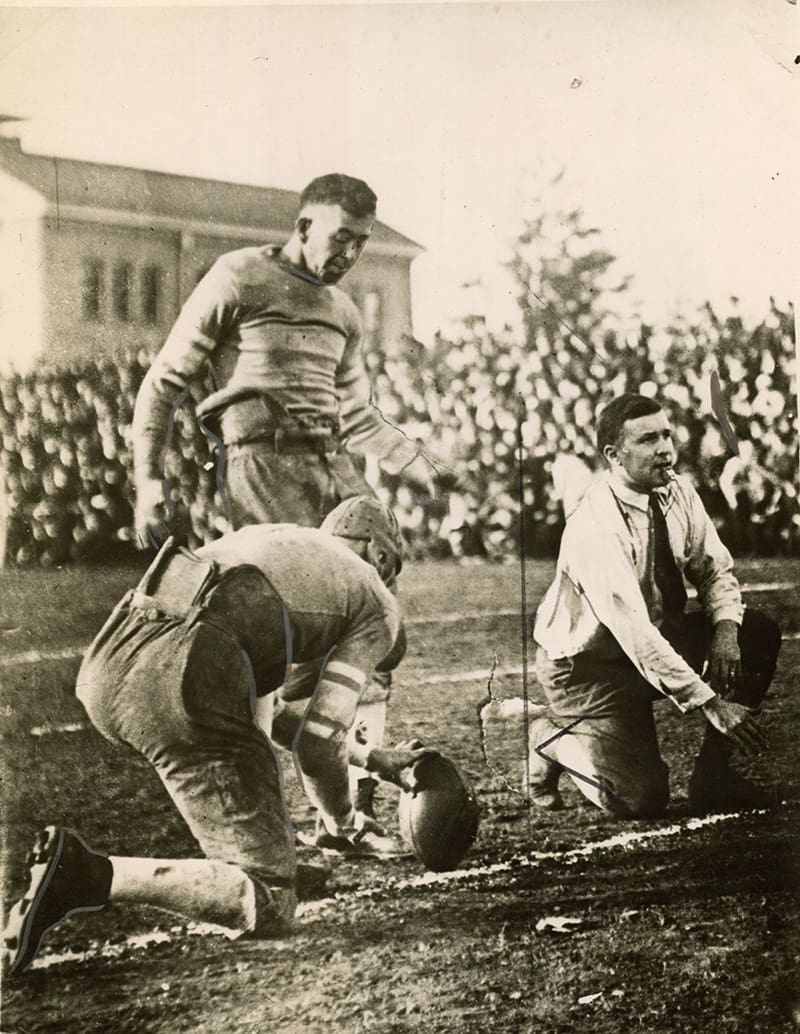
Press photo of Red Weaver kicking his 46th extra point to end the 1919 season with Bo holding
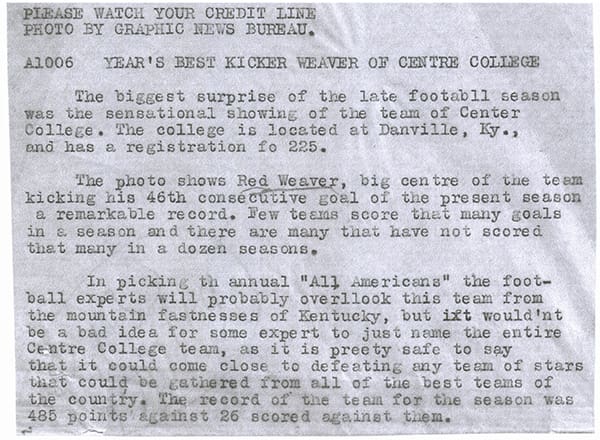
Caption on back of photo about Weaver's kick in Georgetown. Note the use of "Center College" and Weaver's position as being a "centre." The caption has the correct number of points, 485, scored by the Colonels during the 1919 season but is incorrect about the 26 points given up. The total was actually 23. Diane Johnson, Director of Strategic Planning and Communications at Centre and respected historian of the college, discovered the actual shoe that Red Weaver used during his career, which included a consecutive record of extra points kicked which stands to this day, and has featured it in a display of Centre's memorabilia. ( More in Chapter 31 )
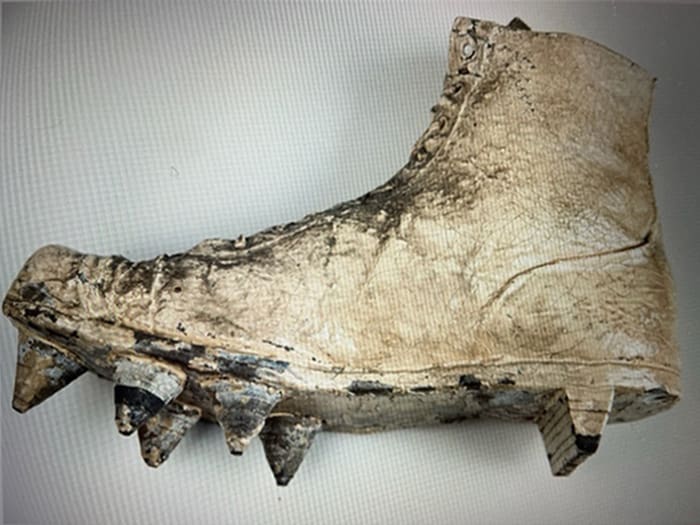
Red Weaver's flat-toed shoe
Bo could have led the nation in scoring in 1919 if he’d had any aspiration to achieve that honor. He ended with 122 points while “Rodg” Rodgers of West Virginia tallied 146.
Going into the DePauw game, Bo trailed Rodgers by just 2 points. However, he handed the ball to Red Roberts twice during that game for easy scores rather than taking it in himself. Also, during the final game with Georgetown, he made sure that three seniors, Allen Davis, Howard Van Antwerp, and Matty Bell, each scored during their last game.
Again, it was all about the team. It was always the team.
Centre was easily the highest scoring team in the country in 1919. The Colonels put 485 points on the board in 535 minutes, remembering the 5 minutes taken off the clock at Georgetown, and were dubbed the “Point-a- Minute Colonels” by the press.

West Virginia finished at 8-2 and scored 326 points to end up a distant second as the most prolific offense.
As impressive as the Colonels’ offense had been, the defense of the Gold and White was even more amazing. Their opponents scored a grand total of 23 points during the 9 games, and the only points which were totally the responsibility of the defense were the 6 points scored by West Virginia during the early minutes of Centre’s 14-6 win in Charleston.
Indiana got a field goal after the Hoosiers had blocked a punt which they had recovered on the Colonels’ 25 and had to settle for 3 points because they couldn’t advance the ball any closer to the goal after 3 unsuccessful runs. Virginia scored after a shanked punt and 2 penalties had given the Wahoos possession on Centre’s 10. Even then, it took 4 plays in order for the Colonels’ goal to be crossed. And, Georgetown scored on the mix-up during a center toss when the free ball was picked up by a lineman.
Three touchdowns, 2 extra points, and 1 field goal. That was the total amount of scoring against Centre in 1919.
On Friday, after the Georgetown game, Howard Reynolds and Eddie Mahan boarded the train for the long journey from Danville back to Boston. Reynolds wanted his readers to have a feeling for what was going on in the world of college football outside of their own area as he typed away during the trip.
Mahan not only wanted the Post readers to also be able to read about his impression of Centre and its team in an article he was preparing on the train, but he was going back to Boston with the mission of reporting back to officials at Harvard about how strongly he felt that Centre should be put in a slot on the Crimson schedule for the upcoming, 1920 season.
Centre’s people felt that everything had gone perfectly during the Bostonians’ visit. They felt that there was a real possibility of Chief Myers’ long-held goal of meeting one of the “Big 3” on the gridiron becoming reality.
Now, all that they could do is wait.
Wait, not only if the Colonels as a team would be heading east for a game during the upcoming season. but whether there would be individual, national recognition for any of the players who'd had such great seasons during the most successful of all of the campaigns since Centre's first game some 40 years previously.
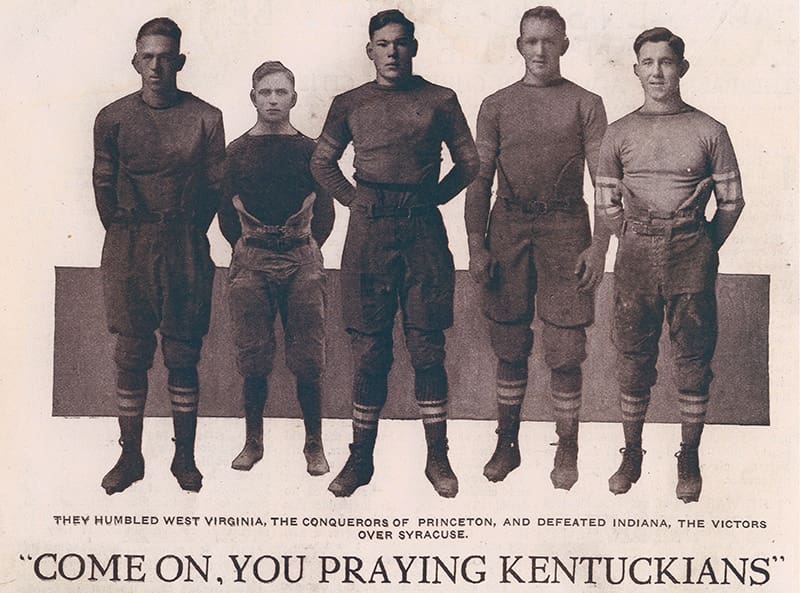
Individuals who Centre hoped would receive national recognition after the 1919 season. Left to right- Red Weaver, Chick Murphy, Sully Montgomery, Red Roberts and Bo McMillin
